Hainanese chicken rice, khao mun gai in Thai, is popular dish not only in Thailand, but in many Asian countries such as Singapore, Hong Kong and Malaysia. Each country serves it slightly differently, with different sauces, but the heart of it is the same: tender-poached chicken served over rice that has been cooked in chicken fat and chicken broth.
This recipe is the Thai version, of course, and it's a dish near and dear to my heart because my grandmother is from Hainan, and this is her signature dish that she makes every time I see her. So if you're looking for authentic Hainanese chicken rice recipe, from an actual Hainanese grandma, this is it right here.
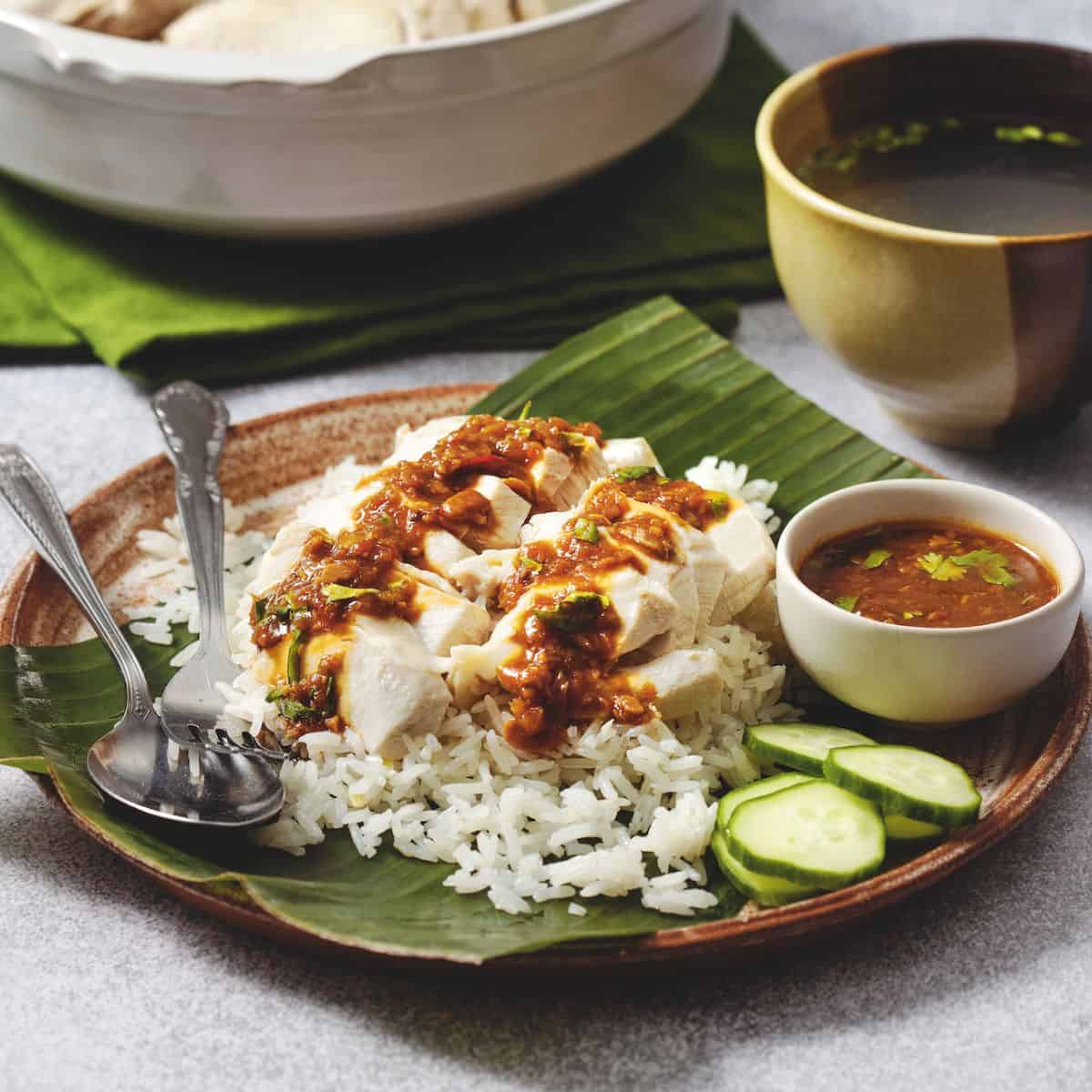
What is Hainanese Chicken Rice (khao mun gai)?
Known as khao mun gai or kao mun gai in Thai, this dish originated on the Chinese island of Hainan (obviously!), which is off the coast of Southern China. There are many Hainanese immigrants in Southeast Asia due to the island's proximity. And indeed, my mother's side of the family are Hainanese immigrants to Thailand!
Hainanese chicken rice is made by first poaching a whole chicken. Then the chicken cooking liquid, which has turned into tasty chicken broth by then, is used to cook the rice. The rice is also first sauteed in rendered chicken fat that you get from trimming excess fat from the chicken.
In my family, we make khao mun gai usually during Chinese New Year or Qingming festival (Tomb-Sweeping Day) because these are days when we poach whole chickens to offer to our ancestors. Once the ancestors have had their share, we bring the chickens home and make delicious Hainanese chicken rice!
Khao Mun Gai in Thailand
Khao mun gai is the epitome of Thai street food. You can find them sold by street vendors, mom-and-pop restaurants, and food courts. It's cheap, fast, delicious, truly the food of the people. It was even featured in my Top 5 Rice Dishes in Thailand video!
Since it was brought into Thailand by Chinese immigrants, you'll find it more in areas with a large Chinese communities, such as Bangkok. But because of its popularity, it is available just about anywhere in the country so you will definitely come across one.
Ingredients
Here are all the ingredients you'll need to make khao mun gai. For amounts, check out the full recipe card below.
I also want to note that this recipe is the traditional method that uses a whole chicken, and it does take time.
If you are looking for something easier, quicker to make, and that uses chicken parts rather than a whole chicken, check out my Easy Hainanese Chicken Rice Recipe that can even be done in a rice cooker!
THE POACHED CHICKEN
- Whole chicken, preferably on the smaller side. If you can get free-range chicken it would also be better for this recipe as they tend to be smaller and more flavourful. If you are shopping at an Asian grocery store, you may find smaller whole chickens with head and feet attached, with the skin slightly more yellow, and these are THE perfect chicken for this recipe!
- Cilantro roots, or 6 cilantro stems
- Garlic
- Onion, rough chopped
- Daikon, cut in big chunks. This is optional and it was not used in my original video but daikon makes for a super sweet, tasty broth and I recommend it!
- White pepper, ground or crushed
- Ginger, sliced
- Fine grain salt
- Green onions and/or cilantro, for garnishing the broth for serving, if desired.
THE RICE
- Jasmine rice
- Chicken fat trimmings, you just need to trim these off the chicken before poaching.
- Chicken broth from cooking the chicken above
- Garlic, chopped.
- Cucumber slices, for serving.
SAUCE OPTION 1: THE CLASSIC - NAM JIM TAOJIEW
If you only make one dipping sauce, this is the one to make. This is the classic Thai dipping sauce that every khao mun gai vendor serves in Thailand.
- Ginger
- Thai chilies
- Tao Jiew (Thai fermented soybean paste). You can also substitute an equal amount of Japanese miso paste of Korean doenjang.
- Sugar
- Black soy sauce, or dark soy sauce. Read more about different types of soy sauce here. If you have sweet soy sauce, you can also use it and reduce the amount of sugar.
- Soy sauce
- White vinegar
- Chopped cilantro, optional
SAUCE OPTION 2: SPICY & SOUR DIPPING SAUCE - NAM JIM HAI LAM
This dipping sauce is not commonly sold by street vendors, but it's the one my grandmother makes and she says this is the "Hainanese style" that is made in her hometown. It's tart, spicy, and bright. My grandma always makes both types of sauces, and I always use them both. I find a mix of the 2 makes for the perfect combo!
- Ginger slices
- Garlic
- Thai chilies
- Cilantro, stems and leafy parts separated and chopped. If you don't like cilantro, green onions will also work.
- Soy sauce
- Lime juice
- Sugar
How to Make Hainanese Chicken Rice
Here is an overview of all the steps to make this recipe. See the recipe card below for all the details and ingredient amounts. If this is your first time, I highly recommend watching the video tutorial to ensure success.
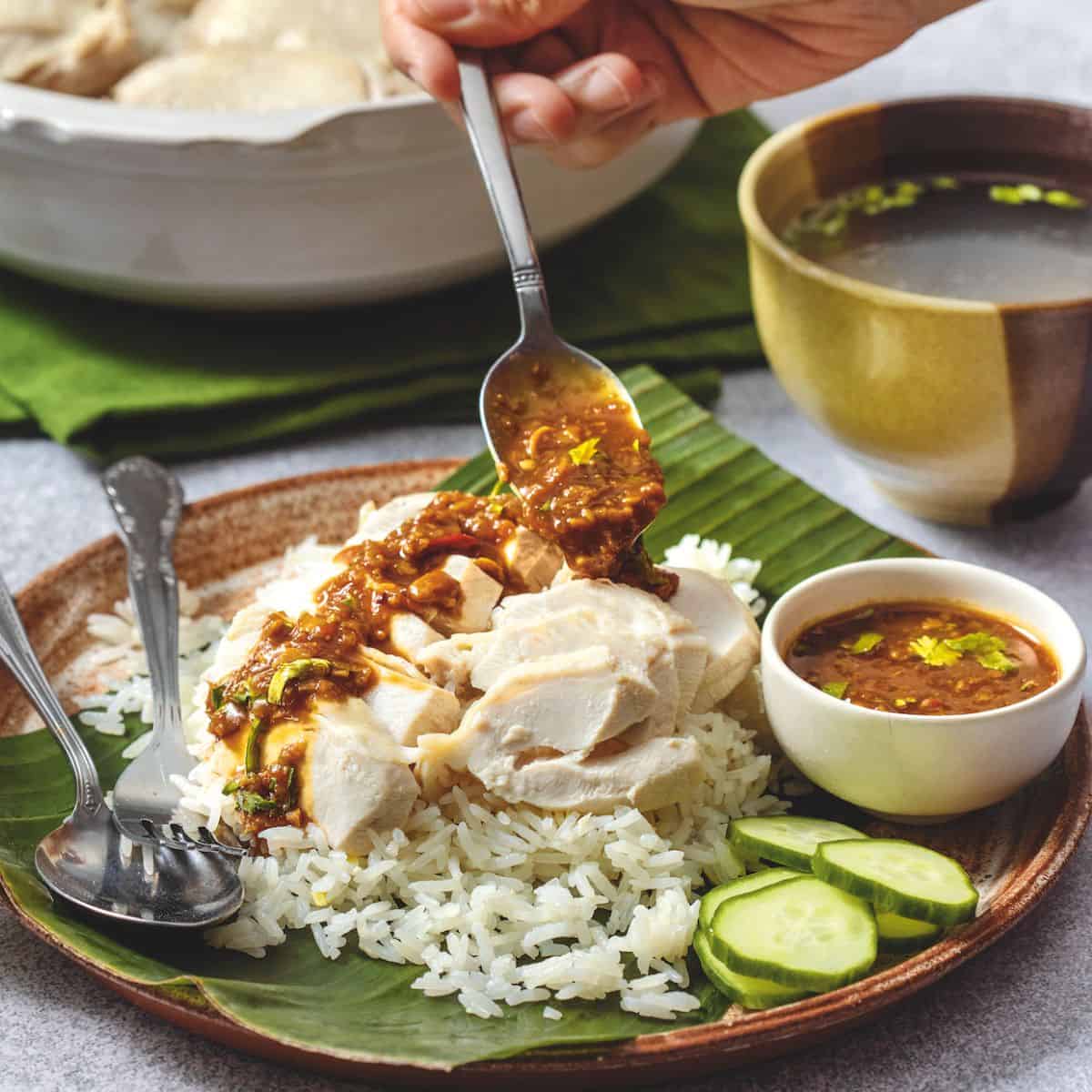
- If your chicken comes with the head and feet, cut off chicken neck, feet, and wing tips and add to a stock pot large enough to put the chicken into. And onions, daikon (if using), garlic, ginger, cilantro roots and white peppercorns. Add enough water to generously submerge all ingredients and simmer for 20 minutes to render a stock.
- Meanwhile, remove excess chicken skin and any fatty bits and add these fat trimmings to the pot you will use to cook the rice; if you're using a rice cooker, put the fat in the pot of the rice cooker. Set it aside for now.
- Once the stock is ready, season with 1 tablespoon of salt and fill the pot about ⅔ full with cold water. Add the chicken to the pot and add more water as needed to keep the chicken submerged.
- On medium high heat, bring the temperature of the water up to 165 - 170 degrees Fahrenheit. If you don't have a thermometer, the water should have lots of steam coming off the top but it is not simmering.
- Once the temperature is reached, reduce the heat to maintain it there. Taste the broth and add more salt as needed so it tastes like a nice soup that's mildly salted. Cook until the chicken's internal temperature registers 165F at the thickest part of the thighs. This takes about 30 minutes for my 2.5 lb chicken, 40-50 minutes for larger chickens. Note: Cooking time starts AFTER water temperature has reached 165F.
- When the chicken is done, remove from the stock and let cool to room temperature. Make the rice while the chicken cools.
For the Rice
- Wash the rice a few times until the water runs mostly clear.
- Heat the collected chicken fat over medium low heat until you've got about 2-3 tablespoon of rendered chicken fat. If you do not have enough rendered fat, supplement with vegetable oil. Remove the solids and discard.
- Add the garlic and saute until golden. Add the rice and toss to coat, cooking it for about 2 minutes until the rice is hot throughout.
- Add the chicken broth (from cooking the chicken) and keep stirring until the rice is thick enough that the fat is mixed into the liquid and no longer floats on top.
- Cover and let cook on low heat until rice is done, about 15 minutes or until the rice cooker clicks off. Make the dipping sauces while the rice cooks.
FOR THE CLASSIC DIPPING SAUCE
- Pound together the ginger and chilies into a rough paste. Then add fermented soybean paste, sugar, black soy sauce, regular soy sauce, and vinegar. Stir until the sugar is completely dissolved. Stir in chopped cilantro, if desired.
FOR THE SPICY & SOUR DIPPING SAUCE
- Pound together garlic, chilies, ginger, and cilantro stems into a rough paste, then add the sugar, soy sauce, and lime juice. Stir to dissolve the sugar and then stir in chopped cilantro leaves.
ASSEMBLY
- Taste the remaining broth and adjust seasoning as needed; we serve a bowl of broth alongside the rice so it should now tastes like a nice soup. You can add some chopped green onions or cilantro to the broth also if you wish.
- Carve the chicken and slice them into thick slices. You can follow this video for instructions: How to carve a chicken.
- Serve the sliced meat over rice, along with sliced cucumber on the side, and a bowl of chicken broth as a palate cleanser. Don't forget the sauces!
FAQ
As mentioned, different countries have different sauces to go with Hainan chicken rice. In Singapore, for example, they serve it with a sauce similar to the Thai sweet chili sauce. In Hong Kong, they serve it with a ginger scallion oil made by pouring hot oil over some finely chopped ginger, green onions and salt. You can definitely try them out!
This is one dish I do not recommend using a pressure cooker for. Yes it take time, but the low temperature cooking is key to getting the best Hainanese chicken with tender, juicy meat. High heat will squeeze all the juices out of the chicken and leave you with tough and dry meat. If anything, sous vide is your best bet!
If you're looking for a faster way to make this dish, check out my Easy Hainanese Chicken Rice Recipe!
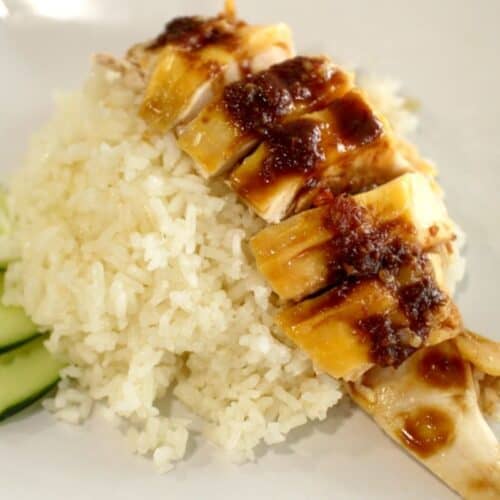
Hainanese Chicken Rice Recipe ข้าวมันไก่ (kao mun gai)
Ingredients
The Chicken
- 1 whole chicken
- 2 Cilantro roots, or 6 cilantro stems
- 4 cloves garlic, crushed
- ½ onion, rough chopped
- 3 -inch section daikon, peeled and cut in chunks, optional
- ½ teaspoon white peppercorns, crushed, or ground white pepper
- 2 slices ginger
- 1 tablespoon fine grain salt
The Rice
- 2 cups jasmine rice, uncooked
- 2 ⅔ - 3 cups chicken broth, from cooking the chicken
- 2 tablespoon chopped garlic
Sauce 1: The Classic Dipping Sauce (Nam Jim Tao Jiew)
- 2 tablespoon finely chopped ginger
- 2 Thai chilies
- 3 tablespoon Taojiew (Thai fermented soybean paste), or substitute miso or doenjang thinned out with a little water
- 1 tablespoon sugar
- 1-2 tablespoon black soy sauce, see note 1
- 1 tablespoon soy sauce
- 1 teaspoon vinegar
- 2 sprigs cilantro, chopped, optional
Sauce 2: Spicy & Sour Dipping Sauce (Nam Jim Hai Lam)
- 2 tablespoon chopped ginger
- 2 cloves garlic
- 2 Thai chilies
- 2 sprigs cilantro, stems and leafy parts separated and chopped
- 2 tablespoon soy sauce
- 2 tablespoon lime juice
- 2 teaspoon sugar, see note 2
Notes
- I've noticed that black soy sauce varies greatly depending on the brand so start out with 1 tablespoon and go from there. If you're substituting "dark soy sauce" for this, use only 1 tablespoon and reduce the amount of regular soy sauce by ½ Tbsp. See this video on the differences between dark and black soy sauce.
- In the video I didn't add sugar because if you're using both sauces together like I usually do, it doesn't really need it. But if you will use it on its own, it needs a the sweetness to balance.
FULL VIDEO TUTORIAL
All my recipes come with step-by-step video tutorials with extra tips not mentioned in the blog post, so make sure you watch the video to ensure success. If you enjoy them, consider subscribing to the YouTube Channel to not miss an episode. Thank you!
Subscribe to my YouTube ChannelInstructions
- If your chicken comes with the head, neck and feet, chop them off along with the wing tips and add to a stock pot large enough to put the chicken into. Add onions, daikon (if using), garlic, ginger, cilantro roots and white peppercorns. Add enough water to generously submerge all ingredients. Bring to a simmer over high heat, then reduce heat to medium and simmer for 20 minutes to infuse the herbs.1 whole chicken, 2 Cilantro roots, 4 cloves garlic, ½ onion, ½ teaspoon white peppercorns, 2 slices ginger, 3 -inch section daikon
- Meanwhile, remove excess chicken skin and any fatty bits, such as around the neck flap and around the chicken cavity opening. Add these fat trimmings to the pot you will use to cook the rice; if you're using a rice cooker, put the fat in the pot of the rice cooker. Set it aside for now.
- Once the stock is ready, season with 1 tablespoon of salt and fill the pot about ⅔ full with cold water (or however much you think is needed to submerge the chicken). Add the chicken to the pot and add more water as needed to keep the chicken submerged.1 tablespoon fine grain salt
- On medium high heat, bring the temperature of the water up to 165 - 170 degrees Fahrenheit. If you don't have a thermometer here's what to look for: the water should have lots of steam coming off the top but is not simmering (no bubbling!).
- Once the temperature is reached, reduce the heat to medium-low, or whatever is needed to maintain the temperature there. Taste the broth and add more salt as needed until it tastes like a nice-but-mildly-salted soup.
- Cook until the chicken is done, flipping the chicken halfway through and keeping an eye on the heat to make sure the water is not simmering. The internal temperature should be 165F at the thickest part of the thighs. This takes about 30 minutes for my small 2.5 lb chicken, and will take 40-50 minutes for larger chickens. Note: Cooking time starts AFTER water temperature has reached 165F.
- When the chicken is done, use tongs to remove it from the stock and let cool to room temperature. Make the rice while the chicken cools.
For the Chicken Rice
- Wash the rice a few times until the water runs mostly clear.2 cups jasmine rice
- Heat the collected chicken fat over low heat until you've got about 2-3 tablespoon of rendered chicken fat. If for some reason you do not have enough rendered fat, you can supplement with vegetable oil. Remove the solids and discard.
- Add the garlic and saute until the garlic starts to turn golden. Add the rinsed rice and toss to coat. Cover with the chicken broth (from cooking the chicken) and stir occasionally until the rice is thick enough that the fat is mixed into the liquid and no longer floats on top. Cover and let cook on low heat until rice is done, about 15 minutes or until the rice cooker clicks off. Make the dipping sauces while the rice cooks.2 tablespoon chopped garlic, 2 ⅔ - 3 cups chicken broth
For the Classic Dipping Sauce:
- Pound together the ginger and chilies into a rough paste. Then add fermented soybean paste, sugar, black soy sauce, regular soy sauce, and vinegar. Stir until the sugar is completely dissolved. Stir in chopped cilantro if using.2 tablespoon finely chopped ginger, 2 Thai chilies, 3 tablespoon Taojiew (Thai fermented soybean paste), 1 tablespoon sugar, 1-2 tablespoon black soy sauce, 1 tablespoon soy sauce, 1 teaspoon vinegar, 2 sprigs cilantro
For the Hainanese Dipping Sauce:
- Pound together garlic, chilies, ginger, and cilantro stems into a rough paste. Add the sugar, soy sauce, and lime juice and stir until the sugar is dissolved. Stir in chopped cilantro leaves.2 tablespoon chopped ginger, 2 Thai chilies, 2 sprigs cilantro, 2 tablespoon soy sauce, 2 tablespoon lime juice, 2 teaspoon sugar, 2 cloves garlic
Assembly
- Taste the remaining broth and adjust seasoning as needed; we always serve a bowl of broth alongside the rice. You can add some chopped green onions or cilantro to the broth also if you wish.
- Carve the chicken, debone the thighs and drumsticks, and slice them into thick slices. You can follow this video for instructions: How to carve a chicken.
- Serve the sliced meat over rice, along with some sliced cucumber on the side, and a bowl of chicken broth as a palate cleanser. Don't forget the sauces!

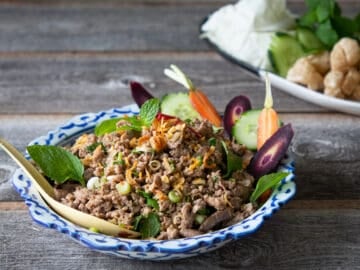

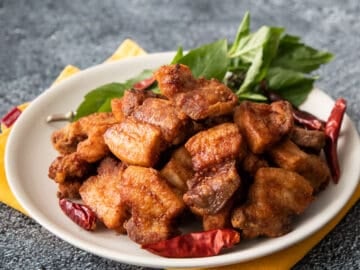
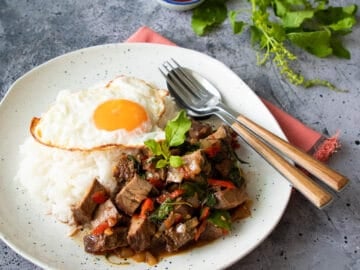

Dani D says
Wow. This was truly amazing. I cannot believe the texture of the chicken. Literally melts in your mouth. We have loved every recipe so far. Thank you!
Pailin Chongchitnant says
So glad to hear, thanks for the review!
Steve says
We made this today and loved it, wondering “is this dish ever served without the sauce(s)?”, as that would be a far more… mellow flavor. We made the classic sauce to serve with it, and were blown away.
PK says
Great true recipe. It's important to scale this based on the weight of your chicken. Usually have to triple it because our birds are almost always more than 7 lbs. Delicious.
Nina says
Best Hainanese chicken rice recipe ever. And the video was so helpful the first time I made it. My family love this one and ask for it often.
Hendrik says
I do like this really much, though it is a bit convoluted and takes about 2h to make - and that's with only one sauce. Such a difference from the everpresent fried chicken or cooked-to-bland-straw chicken.
I skin the bird and add the skin to the stock from the get go. Also I simmer the stock for 30', 20' don't really do much.
Robert says
This one takes time. The chicken is cooked low & slow, resulting in a tender, juicy bird. The chicken itself is a bit bland, so the dipping sauce (she gives recipes for 2, you need at least one) is crucial. The rice, cooked in the broth created when cooking the chicken, is nicely flavored.